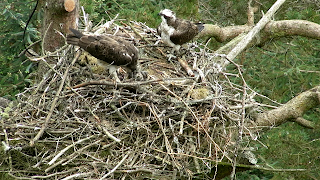 |
| Our three chicks and proud parents |
These soft fluffy type feathers are excellent insulation against cold weather but are not waterproof, so the young chicks are very susceptible to cold at this stage in their lives. Because of this, the osprey parents remain very attentive of their young until they can become more independent. In cold or wet weather the female will shelter the young chicks beneath her. The warm sunny weather means that the chicks can be left for short periods but the parent birds will never be far away, perhaps sitting on a nearby perch to preen, to keep their feathers in prime condition. Any sign of danger, such as a passing crow or predator and the adults will be back on to the nest and ready to protect their young straight away.
The female appeared to be pre-occupied with some nest adornment during the week as she returned to the nest with a larch stick which must have been at least 1.5m in length. She put it across the centre of the nest and perched on it for a while with the young chicks below, looking up at her. Eventually she decided to move it into a side position along the flank of the nest and seemed to be satisfied with her handiwork. Throughout the season, the adult birds add material to the nest and they will often grab a clump of moss from the forest floor and add this to the occupied part of the nest. This will help to keep their living space clean and to prevent from attracting flies.
The young chicks are pretty well house trained too and they can be seen moving into position to point their rear end towards the outside of the nest, to fire excrement away from the eyrie. This is essential hygiene to keep the nest site clean and free from flies which could carry disease.
Herons.
The heron nest remains abandoned since the sad demise of the two chicks and the disappearance of the third egg. It is far too late in the season for the parent birds to attempt to breed again for this year.
Blue Tits
The little blue tit family has finally hatched but over the past few days the number of chicks is going down. The blue tit had a clutch of ten eggs and it seemed to be a full clutch of chicks that had hatched but there were only 6 heads reaching up to be fed today. The very cold spring and the awful summer last year has brought about a decline in number of butterfly and moth caterpillars. Usually the young tits would be seen being fed on juicy green caterpillars but again it would seem that flies and spiders have been offered to the young chicks. This is not as nutritious as the caterpillars which are high in protein and water content. Most of the insects are made up of exoskeleton and are of little value to young which need to grow quickly. The adult bird removes dead chicks from the nest to prevent attracting predators.
No comments:
Post a Comment
Please feel free to leave your comments on the blog. We've got a few house rules:
1. We (Forestry Commission Scotland) will review all comments and reserve the right to not publish them at our discretion.
2. There will be a time delay between submission and posting. Comments posted on a Saturday or Sunday won't be moderated until the following Monday.
3. Please make comments appropriate and relevant.
4. If you've a comment or question about Tweed Valley Ospreys , you can e-mail tweedvalleyospreys@gmail.com as we might not be able to respond here.
5. We won't publish comments that are abusive, indecent, unlawful or defamatory; published comments may be removed at any time; and individuals are personally liable for the comments they submit.
Thanks!